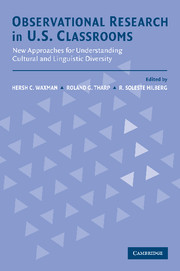 Observational Research in U.S. Classrooms
Observational Research in U.S. Classrooms Book contents
- Frontmatter
- Contents
- Tables, Figures, and Appendixes
- Contributors
- 1 Introduction: Purposes and Perspectives on Classroom Observation Research
- 2 Using Multiple Perspectives in Observations of Diverse Classrooms: The Sheltered Instruction Observation Protocol (SIPO)
- 3 The Standards Performance Continuum: A Performance-Based Measure of the Standards for Effective Pedagogy
- 4 The Uses of the Classroom Observation Schedule to Improve Classroom Instruction
- 5 Development and Use of a Classroom Observation Instrument to Investigate Teaching for Meaning in Diverse Classrooms
- 6 Patterns of Language Arts Instructional Activity and Excellence in First– and Fourth–Grade Culturally and Linguistically Diverse Classrooms
- 7 Using Classroom Observation as a Research and Formative Evaluation Tool in Educational Reform: The School Observation Measure
- 8 Observing School Restructuring in Multilingual, Multicultural Classrooms: Balancing Ethnographic and Evaluative Approaches
- 9 Sociocultural Activity Settings in the Classroom: A Study of a Classroom Observation System
- 10 The Influence of School Reform on Classroom Instruction in Diverse Schools: Findings from an Observational Study of Success for All
- 11 Future Directions for Classroom Observation Research
- Index
- References
2 - Using Multiple Perspectives in Observations of Diverse Classrooms: The Sheltered Instruction Observation Protocol (SIPO)
Published online by Cambridge University Press: 23 November 2009
- Frontmatter
- Contents
- Tables, Figures, and Appendixes
- Contributors
- 1 Introduction: Purposes and Perspectives on Classroom Observation Research
- 2 Using Multiple Perspectives in Observations of Diverse Classrooms: The Sheltered Instruction Observation Protocol (SIPO)
- 3 The Standards Performance Continuum: A Performance-Based Measure of the Standards for Effective Pedagogy
- 4 The Uses of the Classroom Observation Schedule to Improve Classroom Instruction
- 5 Development and Use of a Classroom Observation Instrument to Investigate Teaching for Meaning in Diverse Classrooms
- 6 Patterns of Language Arts Instructional Activity and Excellence in First– and Fourth–Grade Culturally and Linguistically Diverse Classrooms
- 7 Using Classroom Observation as a Research and Formative Evaluation Tool in Educational Reform: The School Observation Measure
- 8 Observing School Restructuring in Multilingual, Multicultural Classrooms: Balancing Ethnographic and Evaluative Approaches
- 9 Sociocultural Activity Settings in the Classroom: A Study of a Classroom Observation System
- 10 The Influence of School Reform on Classroom Instruction in Diverse Schools: Findings from an Observational Study of Success for All
- 11 Future Directions for Classroom Observation Research
- Index
- References
Summary
Mai knew that the teacher wanted her to become a good writer. And the teacher, Mrs. Galinski, had the students write every day in this 2-hour summer school class. For a half hour each morning, they would read a newspaper article individually and then discuss it as a class. Next, they had 30 minutes to write about the topic in their journals. Sometimes Mai understood the topic, like the article about teenagers getting drunk and crashing a car, but at other times she didn't, like the article on global warming, which had a lot of unfamiliar science words. For 20 minutes (after a 10-minute break), students would then volunteer to read their story or essay aloud, but Mai was too nervous about her English skills and her writing ability to speak up. The American students read aloud, and once in a while one of her fellow English as a Second Language (ESL) classmates took the chance too. Mrs. Galinski would comment on the students' texts, but Mai and the other students didn't. The class ended with 30 minutes of sustained silent reading, which Mai enjoyed because she could read what she wanted to and never had to talk about it. At the end of the class, the teacher would collect their journals and mark them in the evening, returning them the next day. Mai would try to understand the teacher's comments, but she wasn't sure her writing was improving. The teacher would write “Awkward phrasing,” “Verb tenses don't match,” “No clear antecedent,” and “Use more descriptive words,” but Mai didn't know what to do.[…]
- Type
- Chapter
- Information
- Observational Research in U.S. ClassroomsNew Approaches for Understanding Cultural and Linguistic Diversity, pp. 21 - 47Publisher: Cambridge University PressPrint publication year: 2004
References
- 3
- Cited by


